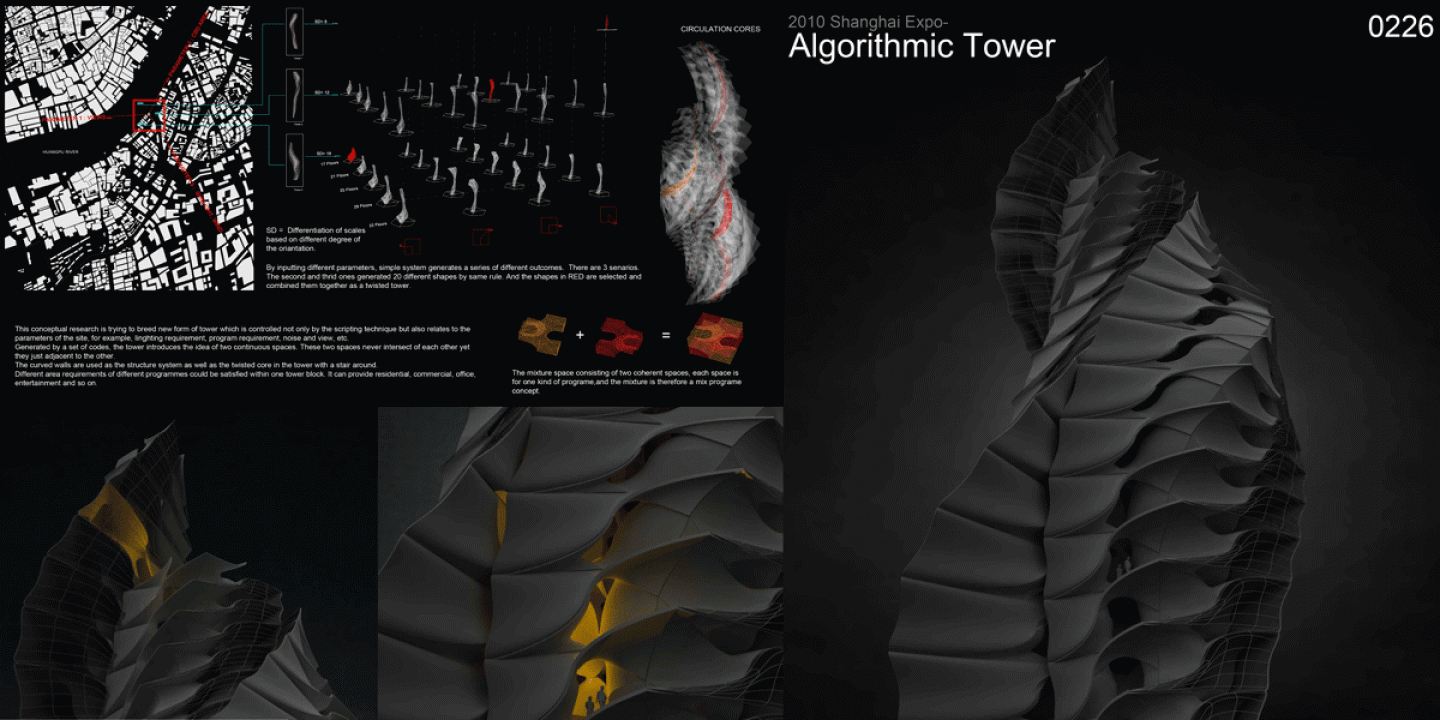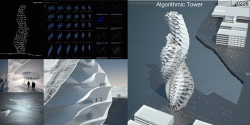Global urbanization now is growing at unpredictable speed, scale and density. The cities in the twenty-first century embody extreme qualities of communication and complexity of interaction. As a matter of fact, large cities’ networks and associative systems seem like growing parametrically. It is reasonable to develop a way in which associative design system can control different local dynamic information to affect and change the outcome of the architectural design. This embeds intelligence into the formation, performance, subdivision and organization of tower spaces, uses, interfaces, structures and so on.
Looking for new forms and modes of spatial organizations is challenging the forces of homogenization and standardization of urbanism. All ancient, historic and contemporary cities order spatial, geometric, distributive hierarchies with subdivision techniques. In response to this observation, an algorithmic tower is proposed to configure the future tower typology in the post-Expo period after Shanghai Expo 2010, China. The density of which is undoubtedly going to be higher and higher after the Shanghai Expo 2010.
The proposal employs code-based scripting methodology with increasing capacity to manage higher orders of complexity required by the cellular network logic. This cellular logic is coded with specific rules of growth and subdivision configured articulate gradual spatial transitions and subdivisions with a segmented mathematical approach to the formation of curvilinear spaces and structures. Each cell is divided into two distinct continuous non-intersecting volumes. At time, one of these volumes escapes the defining limits, thus offering an inclusive interplay between indoors and outdoors. These two interacting spaces maintain their character, while adapting to growth change in direction and gradually transform into a series of vertical aggregates. The skin continues to wrap around, changing its shape, porosity and character in response to the spaces it envelopes, thus enhancing the coherent variety of differentiation. Resulted spaces within greatly vary in their shape and proportions based on the defined boundary’s dimensions, the parameters of the plugged-in component, and the space. The spatial cells are proposed to grow vertically and spirally in new iterative tower typologies, the Algorithmic tower, which defines a coherent yet differentiated organization of sectional movement in a diversity of scales, densities, heights and programmatic mixities. Curved surface modules are controlled locally within bounding discreet volumes and are arrayed serially at various scales to form aggregate building structures, space dividers, and porous facade systems achieving high orders of organizational complexity resulting from simple local rules.
On the multi levels of investigation, the proposed systems are parametrically controlled resulting in varied outputs by altering the initial inputs. The site, on architecture scales, can be reconfigured based on different parameters derived from different organizations, yet following the same rules and procedures. The Algorithmic tower is containing three spiral towers. There are five parameters that influence each tower configurations, its shape and height, as well as its interior space divisions and configurations; two of them determining the general shape of the tower, and the other three control the space dimensions within. Direction, such as major direction of the sunlight or view is a crucial contextual information, become one of the major parameters here. Each level plan is unique, but all of them are under the control of this discipline. The emergency stairs and elevator core are close together, growing and twisting inside the tower. Interiorly, each spiral tower is configured from three main spaces: circulation core, common areas, and private spaces. Their space dimensions are determined by the construction lines of the bounding volume. The result is a space s
2009
2009



